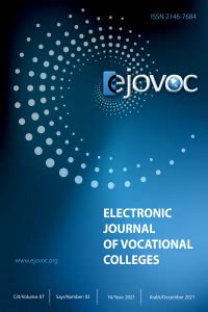A STATISTICAL FEATURE EXTRACTION IN WAVELET DOMAIN FOR MOVEMENT CLASSIFICATION: A CASE STUDY FOR EYES OPEN, EYES CLOSED, AND OPEN/CLOSED FIST TASKS
EEG, electroencephalogram, wavelet transform, feature extraction, classification
A STATISTICAL FEATURE EXTRACTION IN WAVELET DOMAIN FOR MOVEMENT CLASSIFICATION: A CASE STUDY FOR EYES OPEN, EYES CLOSED, AND OPEN/CLOSED FIST TASKS
EEG, electroencephalogram, wavelet transform, feature extraction, classification,
___
- [1] Farwell, L. A. and Donchin, E. (Dec. 1988). Talking off the top of your head: Toward a mental prosthesis utilizing event-related brain potentials. Electroen- ceph. Clin. Neurophysiol., vol. 70, no. 6, pp. 510–523, Dec. 1988. [2] Wolpaw, McFarland, D. J. , Neat, G. W. and, Forneris, C. A. (Mar. 1991). An EEG-based brain-computer interface for cursor control. Electroenceph. Clin. Neurophysiol., vol. 78, no. 3, pp. 252–259. [3] Sutter, E. E. (1992). The brain response interface: Communication through visually guided electrical brain responses. J. Microcomput. Applicat., vol. 15, pp. 31–45. [4] McFarland, D. J., Neat, G. W. and, Wolpaw, J. R. (1993). An EEG-based method for graded cursor control. Psychobiol., vol. 21, pp. 77–81. [5] Pfurtscheller, Flotzinger, D. and, Kalcher, J. (1993). Brain-computer inter- face—A new communication device for handicapped persons. J. Mi- crocomput. Applicat., vol. 16, pp. 293–299. [6] Birbaumer, N., Ghanayim, N., Hinterberger, T., Iversen, I., Kotchoubey, B., Kubler, A., Perelmouter, J., Taub, E. and, Flor, H. (Mar. 1999). A spelling device for the paralyzed. Nature, vol. 398, no. 6725, pp. 297–298. [7] Kubler, A., Kotchoubey, B., Hinterberger, T., Ghanayim, N., Perel- mouter, J., Schauer, M., Fritsch, C., Taub, E. and, Birbaumer, N. (Jan. 1999) The thought translation device: A neurophysiological approach to communication in total motor paralysis. Exp. Brain Res., vol. 124, no. 2, pp. 223–232. [8] Kennedy, P. R., Bakay, R. A., Moore, M. M., and Goldwaithe, J. (June 2000). Direct control of a computer from the human central nervous system. IEEE Trans. Rehab. Eng., vol. 8, pp. 198–202. [9] Schalk, G., McFarland, D.J., Hinterberger, T., Birbaumer, N., Wolpaw, J.R., (2004). BCI2000: A General-Purpose Brain-Computer Interface (BCI) System. IEEE Transactions on Biomedical Engineering 51(6): 1034-1043. [10] Goldberger, A.L., Amaral, L.A.N., Glass, L., Hausdorff, J.M., Ivanov, PCh., Mark, R.G., Mietus, J.E., Moody, G.B., Peng, C-K, Stanley, H.E. (2000). PhysioBank, PhysioToolkit, and PhysioNet: Components of a New Research Resource for Complex Physiologic Signals. Circulation, 101(23): e215-e220 [Circulation Electronic Pages]. [11] Cengiz, Y., Doç, Y., Ariöz, U. (2016). Ayrik dalgacik dönüsümü kullanarak konusma sinyallerinin gürültüden arindirilmasi için uygulama: An application for speech denoising using discrete wavelet transform [pdf]. Retrieved from https://ieeexplore.ieee.org/stamp/stamp.jsp?arnumber=7849377 [12] Misiti, M., Misiti, Y., Oppenheim G. and, Poggi, J. (2007). Wavelets and their Applications. https://doi.org/10.1002/9780470612491 [13] Gupta, V., Mahle, R. and, Shriwas, R. S. (2013). Image denoising using wavelet transform method. Tenth International Conference on Wireless and Optical Communications Networks (WOCN), Bhopal, pp. 1-4, 2013. [14] Shannon, Claude E. (July-October 1948). A mathematical Theory of Communication. Bell System Technical Journal, 27(3), 379-423. [15] Sen, B., Peker, M., Cavusoglu, A., Celebi, F.V. (2014). A Comparative Study on Classification of Sleep Stage Based on EEG Signals Using Feature Selection and Classification Algorithms. Journal of Medical Systems, 38(3)
- ISSN: 2146-7684
- Yayın Aralığı: Yılda 2 Sayı
- Başlangıç: 2011
- Yayıncı: Kırklareli Üniversitesi
AHP-TOPSIS TEKNİKLERİYLE KURULUŞ YERİ SEÇİMİ PROBLEMİNİN ÇÖZÜMÜ: BARIŞI DESTEKLEME HAREKATI ÖRNEĞİ
MİMARİYİ SES İLE TASARLAMAK ÜZERİNE ÖĞRENCİ İZLENİMLERİ
ANALYSIS OF SELLECTED GRID CODE SPECIFICATIONS FOR OFF-SHORE WIND FARM
ECONOMIC DETERMINANT OF SELF EMPLOYMENT IN A DEVELOPING NATION: THE NIGERIA EXPERIENCE
DESIGN OF THE DIRECT CURRENT MOTOR SPEED CONTROLLER WITH EMBEDDED SYSTEM USING FUZZY LOGIC
Yasin AKKUŞ, Çağatay AKDOĞAN, Ayşe AKYOL
INDUSTRY 4 AND INNOVATION IN PROCESS SAFETY OF SMART FACTORIES
